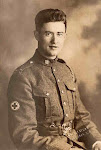Corporal Laughton Joins the CEF
John Laughton was born on January 11, 1895 in Brandon, Manitoba and reported his age as 22 years 5 months at attestation. John survived the war and passed away on February 26, 1893. His son (John Ivan Laughton) for whom this site has been prepared, reported that his father did not see active service in the Great War. Details on the David, John and Ivan Laughton clan are available on the Laughton Family Tree website.
Service Record of John ("Jack") Laughton
Jack Laughton's service record indicates that he attested to the Field Ambulance (Training Depot #11, Army Medical Corps) on June 11, 1917 in Victoria, British Columbia. His "Active Service Report" notes that he was to be made a Corporal on October 18, 1917.
His "Medical History Sheet" notes that he was transferred to the No.5 Coy of the Royal Canadian Garrison Artillery of the Canadian Expeditionary Force on May 15, 1918 as a "Gunner", not in the medical corps. His service record reports that on June 17, 1918 he was "Struck-Off-Strength" from the RCGA on transfer to M.D.6 (Depot Company, Military District #6 Artillery Depot) in Esquimalt, British Columbia. Apparently he remained there for the duration of his service, as the next entry is that he was discharged from M.D.6 in Halifax, Nova Scotia on December 13, 1918. That discharge was signed by the Officer Commanding the Depot Company of the Royal Canadian Garrison Artillery.
Had Corporal Laughton served with the No. 6 Company Canadian Garrison Artillery during the war, he would have served in St. Lucia (West Indies).
The Canadians on Garrison Duty (Published 1919)
During the war between the Allies and the Central Powers Canada was called upon to furnish garrisons for the Bermudas and the island of St. Lucia in order that the Imperial troops which had been stationed there might be relieved for service in the actual theatre of war. Three Canadian battalions, in turn, did duty in Bermuda, — the Royal Canadian Regiment of Halifax, the 38th Battalion of Ottawa, and the 163rd Battalion of Montreal. The two first-named were at a later date to take their places as units in the firing line in France and Belgium, — the Royal Canadian Regiment with the 3rd Division and the 38th Battalion with the 4th Division, —while the 163rd Battalion was broken up upon its arrival in England, there being then no opportunity of fresh troops being sent to the front, except as reinforcements.
Jack Laughton's medical records note that he was hospitalized from April 10, 1918 to April 21, 1918 with influenza at "Carring Hospital, Willows Camp" located in Victoria, British Columbia.
Corporal John Addison Corbett Laughton did not serve in the field (France & Flanders) during his service to the CEF in the Great War, but he was one of the brave Canadians who attested and offered to serve "King & Empire".
Notice:
The CEF WW1 Soldier Blog sites are best viewed on the Internet at the location shown on the bottom of each printed page. A printed copy may have been given to the family member for whom the summary report was prepared, in which case there may be additional attachments. If you are viewing the on-line version, please note that coloured underlined text is a hyperlink to a detailed document. All images in the main blog and the left side panel are also hyperlinked to other reports or images. For additional information, questions or comments e-mail Richard Laughton at or visit the Matrix Project.



